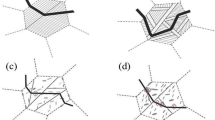Abstract
AHSS is widely used in the automobile industry due to its lightweight and high strength. However, the larger carbon equivalent results in poor weldability and causes a severe performance decrease in the performance of the CGHAZ. The thermal simulation was utilized to analyze the fracture mechanism of the CGHAZ of DP780 high-strength steel, and the microstructure and mechanical properties of the CGHAZ were studied by combining the response surface method (RSM) and the quantum genetic algorithm (QGA). Results showed that the predominant fracture type of CGHAZ was a brittle fracture. Meanwhile, the analysis combining energy dispersive spectrometer (EDS) and metallographic showed that the precipitation of carbides, the increase of the content of upper bainite (UB), and the coarse grains were the main reasons for brittle fracture. When the peak temperature, heating rate, and cooling rate were 1100 °C, 60 °C/min, and 1300 °C/min, respectively, the maximum impact energy of CGHAZ was 7.83 J. The results of optimization combining RSM and QGA showed that the impact energy of CGHAZ was increased by 0.7%, and the error between the results of verification and optimization was 1.93%. Therefore, it has positive significance for reducing the brittleness of CGHAZ by adopting lower heat input and slower cooling rate.













Similar content being viewed by others

Data availability
Data will be made available upon request.
References
Lee JH, Park SH, Kwon HS, Kim GS, Lee CS (2014) Laser, tungsten inert gas, and metal active gas welding of DP780 steel: comparison of hardness, tensile properties and fatigue resistance. Mater Design. 64:559–565
Saeidi N, Ashrafizadeh F, Niroumand B, Barlat F (2015) EBSD study of micromechanisms involved in high deformation ability of DP steels. Mater Design 87:130–137
Moeini G, Ramazani A, Sundararaghavan V, Koenke C (2017) Micromechanical modeling of fatigue behavior of DP steels. Mater Sci Eng A 689:89–95
Kastensson Å (2014) Developing lightweight concepts in the automotive industry: taking on the environmental challenge with the SåNätt project. J Clean Prod 66:337–346
Yan T, Guo YH, Fan XY, Zhu YB, Zhang L (2019) Numerical simulation and welding parameters optimization for minimum deformation of AHSS based on RSM & QGA. Mater Res Express 11:1165e9
Zheng SH, Wu QS, Huang QY, Liu SJ, Han YY (2011) Influence of different cooling rates on the microstructure of the HAZ and welding CCT diagram of CLAM steel. Fusion Eng Des 86:2616–2619
Gao FY, Yu W, Song DJ, Gao Q, Guo LD, Liao ZQ (2020) Fracture toughness of TA31 titanium alloy joints welded by electron beam welding under constrained condition. Mater Sci Eng A 772:138612
Li XQ, Ding ZY, Liu C, Bao SY, Qian H, Xie YC, Gao ZL (2020) Effects of temperature on the local fracture toughness behavior of Chinese SA508-III welded joint. Nucl Eng Technol. https://doi.org/10.1016/j.net.2020.01.020
Kim KH, Moon IJ, Kim KW, Kang KB, Park BG, Lee KS (2017) Influence of carbon equivalent value on the weld bead bending properties of high-strength low-alloy steel plates. J Mater Sci Technol 33:321–329
Indacochea JE, Wang G, Seshadri R, Oh YK (2000) Creep rupture properties of high-temperature bainitic steels after weld repair. J Eng Mater-T ASME 122:259–263
Meng XL, Fan XY, Guo YH (2019) Impact toughness and fracture structure about welded joints of low chromium nickel ferritic stainless steel containing Ce/Ti. Steel Res Int 6:1900037
Bayraktar E, Kaplan D (2004) Mechanical and metallurgical investigation of martensite–austenite constituents in simulated welding conditions. J Mater Process Technol 153-154:87–92
Ioannidou C, Arechabaleta Z, Navarro-López A, Rijkenberg A, Dalgliesh RM, Kolling S, Bliznuk V, Pappas C, Sietsma J, van Well AA (2019) Interaction of precipitation with austenite-to-ferrite phase transformation in vanadium micro-alloyed steels. Acta Mater 181:10–24
Zhang YQ, Jiang SY, Zhu XM, Zhao YN (2016) A molecular dynamics study of intercrystalline crack propagation in nano-nickel bicrystal films with (0 1 0) twist boundary. Eng Fract Mech 168:147–159
Yan T, Guo YH, Fan XY, Wu JJ, Yu J (2019) Microstructure and mechanical properties of thermal simulation CGHAZ of DP780 high strength steel. Mater Res Express 12:126585
Mohammadzadeh A, Azadbeh M, Danninger H (2015) New concept in analysis of supersolidus liquid phase sintering of alpha brass. Powder Metall 58:123–132
Shukla AA, Joshi VS, Chel A, Shukla BA (2018) Analysis of shielded metal arc welding parameter on depth of penetration on AISI 1020 plates using response surface methodology. Procedia Manuf 20:239–246
Konar D, Sharma K, Sarogi VA (2018) Multi-objective quantum-inspired genetic algorithm (Mo-QIGA) for real-time tasks scheduling in multiprocessor environment. Procedia Comput Sci 131:591–599
Acknowledgments
This research is financially supported by the National Construction Science Foundation of China (No. 51475220) and Science and Technology Plan Project of Xuzhou City (No. KC18239). The authors would express their sincere thanks.
Author information
Authors and Affiliations
Corresponding author
Ethics declarations
Conflict of interest
The authors declare that they have no conflict of interest.
Additional information
Publisher’s note
Springer Nature remains neutral with regard to jurisdictional claims in published maps and institutional affiliations.
Recommended for publication by Commission X - Structural Performances of Welded Joints - Fracture Avoidance
Rights and permissions
About this article
Cite this article
Yan, T., Guo, Yh., Fan, Xy. et al. The analysis of the fracture mechanism of thermal simulation CGHAZ of AHSS DP780: based on response surface method and quantum genetic algorithm. Weld World 65, 563–572 (2021). https://doi.org/10.1007/s40194-020-01052-5
Received:
Accepted:
Published:
Issue Date:
DOI: https://doi.org/10.1007/s40194-020-01052-5


